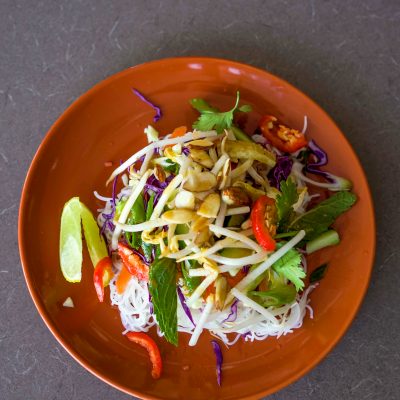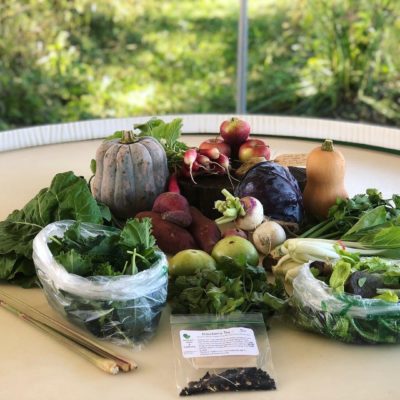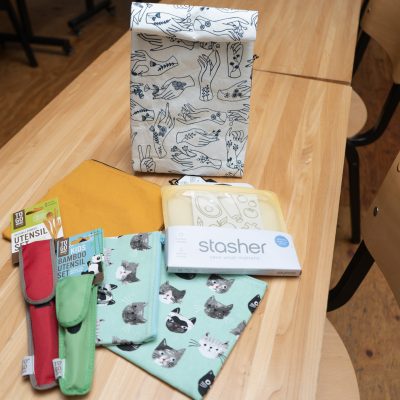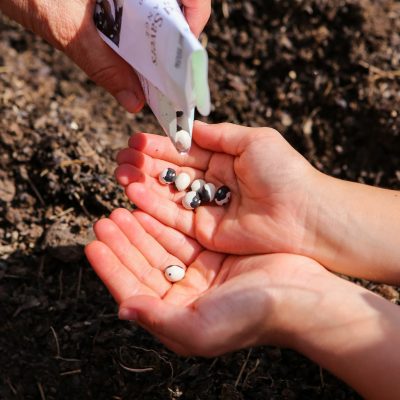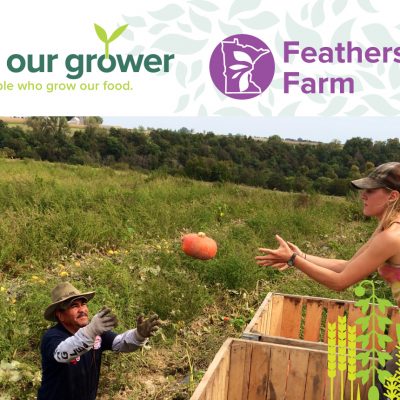Search Results
Fresh Rice Noodle Salad w/ Salad Girl Organic Dressings
Moshky Farm & Gardens
Back to School with Seward Co-op!
Gift Seeds
Seeds are in, and Seward Co-op is diving into spring! Starting your garden from seed and then watching it mature from seedling to fruiting plant can be rewarding, economical and fun.
Considering Minnesota’s relatively short growing season, it can be beneficial to start seeds indoors in spring to give plants a head start before transplanting them into your garden. Each plant has its own unique growing requirements and therefore its own timeline. Refer to Seward Co-op’s Seed Guide as a resource for when to start seeds indoors and transplant outdoors.
Browsing Seward Co-op’s seed racks, surrounded by fresh-cut flowers and an abundance of fragrant citrus, can make the experience of picking out the seeds for your garden inviting—many of the potential options look so delicious and interesting!
However, before you get whisked away by the idea of it all, learn more about Seward Co-op’s seed offerings to determine which brand aligns more with your values and is best for the vision of what you hope to accomplish with your garden—High Mowing Organic, Seed Savers Exchange (a local Community Foods producer), or a combination of the two. Is your primary concern the health of your family, or is it more broad to include environmental biodiversity or healthy habitats for pollinators?
Now, the fun part—make a list of all the crops you want to grow and plot them out to create a feasible plan for your space. We recommend marking a calendar with the dates to start and transplant different crops, using the chart provided on our Seed Guide. Please note some root crops, such as carrots, beets and radishes do not tolerate transplanting. For more home gardening information and resources, please visit the University of Minnesota Extension website.
Know Our Grower: Featherstone Farm
October 24, 2019 @ 8:00 am - 5:00 pm
Come meet the people who grow our food! Featherstone Farm will be at the Friendship store Friday, Oct. 25 from 3-6 p.m.
About Featherstone Farm
Beginning in May with leaf lettuce, through a summer’s harvest of zucchini and cherry tomatoes, into winter squash and carrots in the winter, there’s hardly a month that Featherstone isn’t represented in the co-op’s Produce department. The farm is certified organic and is dedicated to creating a truly sustainable agriculture system. That includes geothermal heating and cooling for the packing shed, as well as a solar array that generates about 60% of the farm’s energy. Featherstone also operates a large community-supported agriculture program.
Know Our Grower: Featherstone Farm
October 16, 2019 @ 8:00 am - 5:00 pm
Come meet the people who grow our food! Oct. 25 Featherstone Farm will be at the Friendship store from 3-6 p.m.
About Featherstone Farm
Beginning in May with leaf lettuce, through a summer’s harvest of zucchini and cherry tomatoes, into winter squash and carrots in the winter, there’s hardly a month that Featherstone isn’t represented in the co-op’s Produce department. The farm is certified organic and is dedicated to creating a truly sustainable agriculture system. That includes geothermal heating and cooling for the packing shed, as well as a solar array that generates about 60% of the farm’s energy. Featherstone also operates a large community-supported agriculture program.
Start Your Plants: Seeds are in!
Seeds are in, and Seward Co-op is diving into spring! Starting your garden from seed and then watching it mature from seedling to fruiting plant can be rewarding, economical and fun.
Considering Minnesota’s relatively short growing season, it can be beneficial to start seeds indoors in spring to give plants a head start before transplanting them into your garden. Each plant has its own unique growing requirements and therefore its own timeline. Refer to Seward Co-op’s Seed Guide as a resource for when to start seeds indoors and transplant outdoors.
Browsing Seward Co-op’s seed racks, surrounded by fresh-cut flowers and an abundance of fragrant citrus, can make the experience of picking out the seeds for your garden inviting—many of the potential options look so delicious and interesting!
However, before you get whisked away by the idea of it all, learn more about Seward Co-op’s seed offerings to determine which brand aligns more with your values and is best for the vision of what you hope to accomplish with your garden—High Mowing Organic, Seed Savers Exchange (a local Community Foods producer), or a combination of the two. Is your primary concern the health of your family, or is it more broad to include environmental biodiversity or healthy habitats for pollinators?
Now, the fun part—make a list of all the crops you want to grow and plot them out to create a feasible plan for your space. We recommend marking a calendar with the dates to start and transplant different crops, using the chart provided on our Seed Guide. Please note some root crops, such as carrots, beets and radishes do not tolerate transplanting. For more home gardening information and resources, please visit the University of Minnesota Extension website.
New Seward-made Items in Stores
Our staff works hard year-round to make great food for our owners and shoppers. Seward employees bring new ideas and recipes to the Seward Co-op Creamery Café production kitchen, so what’s in stores is always fresh and fits the season.
Look for these and other new Seward-made items this winter.
Garlic Kielbasa
Seward-made Garlic Kielbasa is half beef, half pork and features local Community Foods producer Peterson Craftsman Meats in Osceola, Wisconsin. In Poland, the sausage is known as wiejska, which means rural. Paprika and marjoram give classic kielbasa flavor to ours. It’s smoked hot over cherry and hickory wood. Pair with scalloped potatoes, cabbage, stew, sauerkraut and onions.
Swedish Potato Sausage
Yukon Gold potatoes make this Scandinavian holiday sausage light and fluffy. In Sweden, it’s known as potatis korv and is cooked by poaching the links and then browning lightly in butter. The Swedish Potato Sausage is crafted using pork from local Community Foods producer Peterson Craftsman Meats in Osceola, Wisconsin. The sausage is seasoned mildly with white pepper, nutmeg and bay leaf—and pairs with casserole, stew, pickled herring and sauteed mushrooms.
Sweet Spanish Sausage
Launching Dec. 15, this traditional Catalan sausage—called Butifarra Dulce—is popular during the winter holiday season. The flavors are reminiscent of egg nog, only enhanced by the traditional cooking method of poaching in water or sweet wine with cinnamon and lemon zest. This sausage features pork and honey from Community Foods producers Peterson Craftsman Meats and The Beez Kneez, as well as sherry, heavy cream, salt, black peppercorn, grains of paradise, lemon zest and sweet cinnamon. Pair with caramelized apples, polenta, braised kale and chickpeas and Tortilla Española.
Haggis Sausage
Enjoy a taste of Robert Burns Day (Jan. 25) with haggis, the national dish of Scotland that inspired this limited-run sausage. Serve with turnips and potatoes—or roasted carrots from Featherstone Farm, a local Community Foods producer in Rushford, Minnesota.
Caramel Shortbread
Our bakery staff whipped up this twist on a popular crunchy caramel candy bar. Seward-made Caramel Shortbread is sweet and rich, with buttery caramel and dark chocolate on a tender crust and garnished with toasted pecan and finishing salt. The dairy, flour and chocolate are sourced from Community Foods producers.
Chocolate Hazelnut Biscotti
This might as well be called the Community Foods biscotti, as the chocolate, flour and butter used to make it are from vendors who are part of the program. It’s rich, nutty and chocolatey (of course), with hints of toasted hazelnut, coffee and spice. Dip in a coffee or an Egg Nog Latte—both available at the Deli counter right by the baked goods.
Mushroom Stroganoff
With 19th-century Russian origins, stroganoff has become a tradition in Minnesota. Ours is rich, creamy and well-seasoned and includes ingredients sourced primarily from Community Foods vendor Co-op Partners Warehouse and Albert’s Organics: shiitake mushrooms, vegetable stock, bow tie pasta, white wine, sour cream, all-purpose flour, butter, garlic, salt, yellow onion, thyme and black pepper.
Vegan Mac and “Cheese”
A comfort food favorite made without the ingredient that is its namesake. Ace Fox, production shift lead, perfected the recipe at home before introducing it to Grab & Go. “It’s made with a combination of soaked cashews, coconut milk, boiled vegetables and nutritional yeast, which gives it the creamy texture that people might miss about cheese,” Ace said. “It’s a great alternative for those of us who don’t consume dairy.” Local Community Foods producer Heartbeet Farm in Zumbro Falls, Minnesota, provides the carrots and potatoes for this recipe.
Essential Winter Recipe: Beef Shank Bourguignon
Beef Bourguignon is one of the most quintessential braises. This recipe utilizes a lower cost cut of beef: the shank. It’s flavorfully marbled and ideal for a long, slow-cooking recipe. Your home will smell amazing, and the meat will fall off the bone.
Seward Co-op’s Meat and Seafood department is accepting orders now for special holiday cuts. Place your order now at the Meat counter!
Ingredients
1 large beef shank, approximately 2.5 lbs.
1 large onion, diced small
3 stalks celery, diced small
3 large carrots, cut into 1-inch chunks
1/2 lb. button mushrooms, quartered
salt
1 tsp. black pepper
1/2 tsp. clove or several whole cloves
3/4 c. red wine
2 c. organic Seward-made beef stock (suggest doubling if using Dutch oven)
1 Tbsp. apple cider vinegar
1 heaping Tbsp. minced garlic
2 rosemary sprigs
4 thyme sprigs
4 Tbsp. Seward-made tallow or duck fat for searing
Cast-iron skillet
Directions
Heat 2 Tbsp. tallow in skillet on high heat. Pat shank dry. Season liberally with salt and pepper. Sear shank on all sides. Set aside. With tallow, sauté onion, carrot and mushroom. Add garlic and herbs. Stir frequently. Remove vegetables; set aside. Add wine and scrape to deglaze. Add vinegar and stock. Bring to a low boil, reduce heat and cover tightly with lid. Braise 3.5-4 hours. Add vegetables and herbs back into the skillet for last hour to 90 minutes. When the meat is tender, remove and set aside tented in foil to rest. Strain liquid, return to pot, simmer and reduce until thickened. Enjoy!

